#Chrétien de Troyes
Text
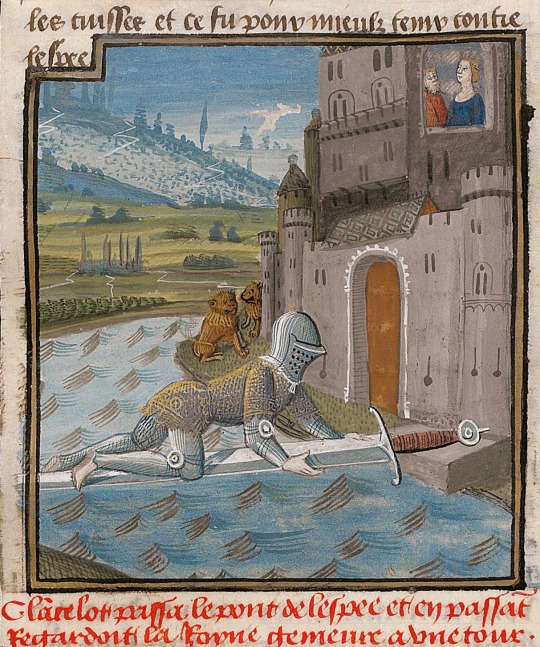
Lancelot crossing the Sword Bridge
Miniature illustration from a four-volume manuscript made for Jacques d'Armagnac, Duke of Nemours. Workshop of Évrard d'Espinques. Circa 1475.
#lancelot#launcelot#sir lancelot#arthurian#knight#knights#chivalry#chivalric romance#medieval#mediaeval#middle ages#chrétien de troyes#art#sword#bridge#guinevere#castle#camelot#meleagant#kingdom of gorre#illuminated manuscript#britain#france#mythology#queen#damsel in distress#realm#évrard d'espinques#jacques d'armagnac duke of nemours#europe
467 notes
·
View notes
Note
Do you have a guide/a recommended reading list for getting into Arthurian legends? I’ve been really getting into it in the past few months but I feel like I’m missing out on a lot of the foundations of it. (If you don’t and this is too big of an ask totally feel free to ignore this lol)
hello, anon.
i don't currently although i have plans to add another page to my blog listing medieval texts as well as links to download pdfs of them. i have english translations of texts originating in belarussian, dutch, french, german, hebrew, italian, latin, middle english, and last but not least, welsh.
in the mean time, i've collected for you some key texts that are readily available to read for free online!
le morte d'arthur by sir thomas malory [part 1] [part 2]
the history of the britons by nennius [here]
the mabinogion translated by lady charlotte guest [here]
four romances by chrétien de troyes [here]
parzival by wolfram von eschenbach [part 1] [part 2]
the wedding of sir gawain and dame ragnelle translated by thomas hahn [here]
sir gawain and the green knight translated by j. r. r. tolkien [here]
better translations/formatting forthcoming! enjoy. :^)
#arthurian legend#arthurian legends#arthuriana#le morte d'arthur#sir thomas malory#the history of the britons#nennius#the mabinogion#lady charlotte guest#chrétien de troyes#chretien de troyes#parzival#wolfram von eschenbach#the wedding of sir gawain and dame ragnelle#sir gawain and the green knight#ask#answered#book reccs#book reccomendation#sources#my post
194 notes
·
View notes
Text
Lucian's Library 7
Feel free to suggest never written books you wish you could read.
Some items suggested by impatient readers for still living authors.
#Unfinished Tales#JRR Tolkien#James Joyce#Chrétien de Troyes#Holy Grail#Arthurian Legend#Medieval Literature#Doris Egan
60 notes
·
View notes
Text

Gawain, Clarissant, Igraine and Morgause at the château des Merveilles
From Le Roman de Perceval ou le conte du Graal, by Chrétien de Troyes
#arthuriana#gawain#sir gawain#perceval#chrétien de troyes#clarissant#igraine#morgause#arthurian literature#arthurian legend#queen#knight
371 notes
·
View notes
Text
Love without fear and without dread is fire without flame and without heat;
Chrétien de Troyes, from ‘Cligès’, tr. L. J. Gardiner
188 notes
·
View notes
Text
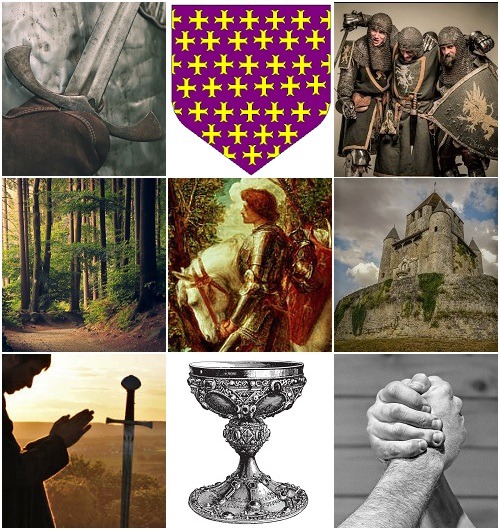
Mythology: Sir Percival
Any wise man fears open spitefulness, whether it be in seriousness or in jest.
#chrétien de troyes#Perceval: The Story of the Grail#knights of the round table#knights of camelot#arthurian legend#arthurian mythology#arthurian literature#arthurian lore#sir percival#percival#parzival#knights#merlin bbc#stories#Story aesthetic#story moodboard#mythology aesthetic#Mythology moodboard#characters#character aesthetic#character moodboard#moodboard#aesthetic#grail knights
30 notes
·
View notes
Text

The Knight of the Cart Comedic Retelling | 17k | Mature | Complete
Comedy, Retelling, Comedic Retelling, BAMF Lancelot, badassery and heroism, Adventures, Kidnapping, Swordfighting, Tournaments, A Heap of Modern References, Author Comments, Knights being Dramatic, Queens being Dramatic, Drama, But this stays faithful to the original so you also have, Animal Death, Fake rape, and by that I mean that a lady stages an attempted rape and then calls it off, Suicide Attempt for Dramatic Purposes, Blood, Death
It is Banquet Day in Camelot! Everyone at court is happy and celebrating and eating, and Kay is being very proud, as he is the seneschal of Camelot, and he’s very happy he’s managed to throw a successful party.
Suddenly, the doors open and in steps a Bad Knight.
Bad Knight tells King Arthur, “I have imprisoned thousands of your people into my domains because I Am Evil! I’m just telling you that because you’re a huge loser, and you’re definitely not strong enough to save them. You don’t even have enough resources to do it! Cry, bitch!”
Arthur goes, “Eh, sadness :(( I will cry now.” Weeping sounds ensue.
Bad Knight goes to leave, and then stops at the door. “You know what,” he says, “I’m gonna be generous. Have one knight escort the Queen to the forest. If the knight manages to best me in a duel, you can have your people back. If he can’t, I’m taking him and the Queen!”
Once upon a time, the author tried to write a very short, light, and funny Knight of the Cart summary for her friends who were curious to know what it was all about. 17k later, she realised that while it was quite light and quite funny indeed, she had failed spectacularly in making it an actual summary. So you get a comedic retelling instead.
Read on Ao3
#arthuriana#arthurian literature#retelling#the knight of the cart#lancelot du lac#guinevere#chrétien de troyes#maya writes#this was supposed to be a lot shorter lol#but i had too much fun writing it not to share
33 notes
·
View notes
Text
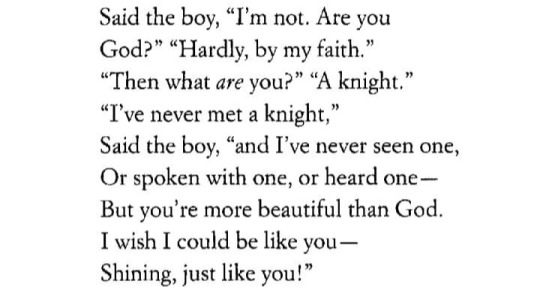
HELLO.
#i'm reading de troyes for the first time and by god. it's doing something to my little grey cells#you are more beautiful than God ‼️‼️#arthuriana#chrétien de troyes#percival#mythology tag
10 notes
·
View notes
Text
"perceval" is like that meme with a mom at a pool and the happy kid she's playing with is carados and the miserable drowning kid is gawain and the long abandoned skeleton at the bottom of the ocean is perceval
9 notes
·
View notes
Text
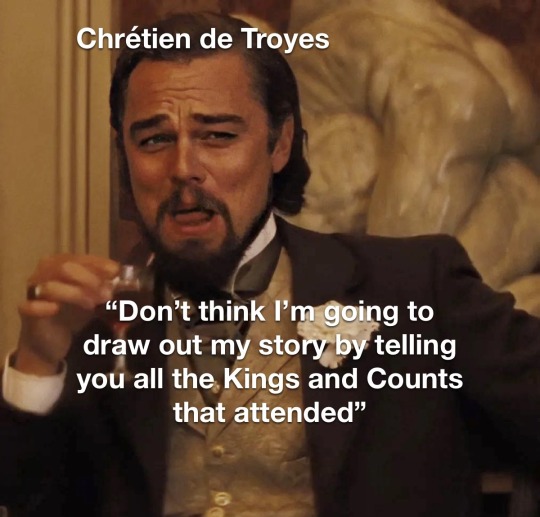
Yeah Geoffrey, who would ever include something like that?
#me I need that#*sobs*#it’s so hard trying to make a wiki without actual character names#I’m on knight (XI) already#arthuriana#chrétien de troyes#medieval literature#arthurian literature#King Arthur
9 notes
·
View notes
Text
Marie de France
For six years, from March 1181 to May 1187, Marie exercised the comital office as regent for her son Henry (II). She did so vigorously and alone, without restriction by a regency council. In the great hall of her palace in Troyes, which served as the political and administrative center of the county, as well as in her other castle towns, Marie sat with a small council of barons and administrative officers to discharge all the routine business of medieval rulers: receiving petitioners, arbitrating and settling disputes, making benefactions to churches, confirming private transactions, receiving homages, confiscating fiefs and granting new ones. Since her acts continued to be drawn up by the same chancery officials who had served her husband, they remained the same in form and content. With the notable exception of appointing a new marshal, Geoffroy of Villehardouin, in 1185, she made no discernible changes in her husband's officers or policies. Although feudal tenure by women apparently increased precisely during her rule, we cannot say whether she fostered that practice. Her court, however, was perceived as being receptive to women, several of whom sought her confirmations at critical junctures in their lives.

In 1181 Marie found herself widowed with four young children — Henry II was fifteen, Marie seven, Scholastique five or six, and Thibaut III only two. She considered marrying the recently widowed Philip, count of Flanders (1168-91), the son of her husband's old friend and crusade companion count Thierry. Philip and Marie were about the same age and well acquainted: a decade earlier he had sponsored the betrothal of her two oldest children, Henry II and young Marie, to the children of his sister Margaret, countess of Hainaut. Philip went so far as to seek a papal dispensation for his marriage to Marie, since they were indirectly related, but then, for unknown reasons, broke off negotiations. Marie, at thirty-nine, seems not to have sought another marriage. Thereafter she was preoccupied with completing the marriages between her children and the children of Margaret and count Baldwin V, who had renewed, broken, revised, then delayed carrying out the marriage contract between his only son and Marie's daughter. Countess Marie called on her in-laws to force the elusive count to deliver the groom; Gislebert of Mons describes the scene at Sens where the countess, the archbishop of Reims, the counts of Blois and Sancerre, and the duke of Burgundy cornered Baldwin, perhaps threatening him, if he did not follow through with the marriage, which finally did take place (January 1186). Marie then trumped Baldwin at his own game by ignoring the second part of the contract and arranging her own son's marriage to the infant heiress of Namur instead of to Baldwin's daughter.
When Henry II (1187-90) assumed the countship, Marie retired to Meaux, probably with her youngest son Thibaut, then eight. The forty-twoyear-old countess could not have imagined that she would ever rule again. But the fall of Jerusalem to Saladin on October 2, 1187 electrified France, and young Henry II was swept up by the wave of enthusiasm for a new crusade to recover the holy city. In May 1190 the unmarried count departed with a large contingent of barons and knights on the Third Crusade, leaving his mother as regent once again. Marie ruled in his absence (he died overseas in September 1197), then continued to rule until her death in March 1198 at fifty-three. In all, she had ruled the county over fifteen years — in her husband's absence, as guardian for her oldest son and then in his absence, and finally in the last months of her life as guardian for her second son, Thibaut.
Although she was countess of Champagne for over thirty years, half of them as ruler, we know little about Marie's life and personality beyond her official acts. She seems to have been close to her half-brothers Geoffroy Plantagenet, for whom she dedicated an altar in Paris, and Richard the Lionheart, with whom she shared Adam of Perseigne as confessor, as well as with her half-sister Margaret, who spent Christmas 1184 with Marie and queen mother Adèle. Perhaps Marie saw her sister, countess Alix of Blois, and her mother, Eleanor of Aquitaine, after her parents were divorced in 1152, but there is no firm evidence of any meeting. For her husband Henry she ordered a sumptuous tomb placed in the center of the church of Saint-Etienne of Troyes next to the comital palace, but she herself chose to be buried at Meaux.

Marie's role as literary patron now seems secure. She could read vernacular French and probably Latin as well, given her education at Avenay, and she had a personal library, although its contents are not known. Chrétien de Troyes and Gace Brulé state that they wrote at her request, and she seems also to have patronized Conon de Béthune and Huon d'Oisy. The collegiate chapter of Notre-Dame-du-Val, which Marie founded in Provins with thirty-eight prebends, seems to have supported not only Chrétien but also his continuator Godfrey of Lagny, as well as the earliest known copyist of Chrétien's romances, Guiot of Provins. Perhaps Marie'sinterest in lyric poetry and romances dates from her married years, for the works she is know to have commissioned as a widow in the 1180s are all translations of religious texts: Psalms (Eructavit), Genesis, and possibly a collection of sermons by Bernard of Clairvaux.
Theodore Evergates - Aristocratic Women in Medieval France
#xii#theodore evergates#aristocratic women in medieval france#marie de france#countess of champagne#history of champagne#henri i de champagne#henri ii de champagne#thibault iii de champagne#marie de champagne#geoffroy de villehardouin#baudouin v de hainaut#adèle de champagne#alix de france#geoffroy plantagenêt#richard coeur de lion#chrétien de troyes#gace brulé
8 notes
·
View notes
Note
Hi! Your flowchart is amazing, and I'm so excited by the literature list you made. However, I was wondering if you know which book is best to start reading more about Arthurian legend? I have only collected knowledge through osmosis, so I have no clue where or how to start learning more. Thank you for your time and have a nice day!
hello!
thank you, i'm glad they're helpful for you! i did answer a similar ask about what medieval texts to begin with here and link to free resources, but the formatting is hard on the eyes, and now that my own collection is available, i'll reiterate. all suggested translations are available on my blog.
le morte d'arthur by sir thomas malory: you'll get the most mileage out of this book as malory sourced a broad spectrum of stories to incorporate them into a single text, which includes arthur's conception, pulling the sword from the stone, receiving excalibur from the lady of the lake, marrying to guinevere, young gawain's knighting and first quest, tristan and isolde's romance, the grail quest, final battle at camlann etc. plus malory himself invented some of the most iconic stories, such as gareth's time as the kitchen boy, beaumains. with this book alone, the majority of retellings will make sense to you. but be warned it can be extremely dry (and confusing timeline wise, calogrenant dies twice bc malory couldn't keep his own story straight!), i recommend the keith baines translation as it's rewritten into prose like a novel.
the vulgate cycle: it's 10 books. i know it's 10 books. but it's simply the best. the truncated nature of malory's le morte d'arthur leaves the majority of characters reduced to singular traits (orkney bros the mindless killers, priggish grail knights etc.) which has negatively influenced many retellings since imo. this is not an issue with the vulgate where everyone has a little more nuance and depth, even the bad guys, but especially the characters we're supposed to root for like lancelot and gawain. many fun characters who were cut from le morte d'arthur are fully developed here like half-giant galehaut and gawain's baby mama the lady of lys. i'm putting it high on the list bc i simply think more people should try it. i recommend the translation edited by norris j. lacy. he's incredible and i love all of his translation work. footnotes right in the margin will remind the reader of past references and explain language subtleties lost in translation (like puns) or indicate what was changed for ease of understanding (sometimes the scribes made mistakes and named the wrong character, which lacy will fix and then note he fixed). so if one can get past the sheer volume of text, it's a wonderful read, and i even have specific stories within it i could recommend. but i digress...
sir gawain and the green knight: it goes without saying this poem is iconic. the pearl poet (as the anonymous author is called) wrote beautifully and the version of gawain here is a much kinder portrayal than what he appears in the post vulgate, which was a major source for malory's le morte d'arthur. the beheading exchange/game is the focus here, although this motif will appear in many other texts, such as perlesvaus, and the sgatgk story appears in the majority of retellings that include gawain, so it's a must read. i recommend the j. r. r. tolkien translation (the audiobook version of this translation is phenomenal, like music).
four arthurian romances + the story of the grail by chrétien de troyes: except you can skip cligés bc its mediocre at best. really what you'll need from this is knight of the cart (the first ever story in which lancelot appears and he's very pathetic and weepy and insane and lovable haters dni), knight with the lion (gawain's cousin yvain gets a pet lion, fights a dragon, gets married, gets divorced, goes mad, recovers, gets married again...), erec and enide (worst husband in the universe), and the story of the grail (perceval and gawain adventures). a version of these stories were adapted into le morte d'arthur and the vulgate (except for yvain's lion which is a bummer!). i recommend the nigel bryant translation of perceval and william kibler translations for the rest. when you reach the end of the story of the grail and it cuts mid-sentence...well, sadly we don't know what happened to poor chrétien that kept him from completing his story. but there are four continuations written by other people, plus the german parzival is great as well (and has one of my favorite of gawain's wives, the haughty maiden of logres, orgeluse).
the mabinogion: some of the same stories as chrétien but of welsh origin plus extras. haters will try to pit two bad bitches against each other, but these texts go hand in hand. i like the whimsical vibes of this version and the magical powers given to the characters, such as kay's ability to grow to the size of a tree and set things on fire with his hands or bedwyr's ability to strike faster than all other knights despite having only one hand. it also gives owain (welsh version of yvain) an army of ravens that kill people in addition to his lion, arthur has an invisibility mantle (also referenced in the welsh triads), and the whole gang fights the demon boar twrch trwyth to steal the golden comb off his head. good stuff. i recommend the translation by lady charlotte guest.
the wedding of sir gawain and dame ragnelle: obviously this has to be included. i'm biased but at the same time, it is supposed that sir thomas malory actually wrote this poem! which i think is pretty neat. additionally, 99% of retellings include ragnelle as gawain's wife. in fact, excluding the ones in which he doesn't have a partner at all, i can only think of one in which he marries someone else. dame ragnelle is the people's darling, all of us arthurian authors agreed that in spite of our differing opinions about everything else in the stories, she is the wife of all time. and we're right. a thing of beauty. this text does not have a translation, it's just in middle english, which can be challenging to read. this version edited by thomas hahn has footnotes to help or otherwise i recommend the version retold by selina hastings and illustrated by juan wijngaard, it's gorgeous, and includes all the fun supporting cast like kay and guinevere.
this was a long list with probably more explanation than necessary but it can be difficult to narrow down a single place to begin with arthuriana as each story builds on the literary tradition that came before. everyone is sharing and influencing one another so stories and motifs are repeated, each author writes for their time, slightly altering the technology and culture to reflect their own lived experience, so the narrative evolved as the centuries passed into what we have today. thanks for this ask and hope you enjoy reading!
#arthurian legend#arthurian legends#arthuriana#king arthur#queen guinevere#merlin#sir lancelot#sir gawain#le morte d'arthur#sir thomas malory#the vulgate cycle#the post vulgate#vulgate#post vulgate#sir gawain and the green knight#sgatgk#chretien de troyes#chrétien de troyes#the mabinogion#the wedding of sir gawain and dame ragnelle#reading recommendations#book reccomendations#book reccs#ask#ooutruneverything#arthurian preservation project#my post
33 notes
·
View notes
Text

El conte del Greal, de Chrétien de Troyes, té elements que en demostren l'antiguitat més enllà del relat medieval que és. És una llegenda molt antiga, de les poquíssimes que ens han arribat d'uns temps realment pretèrits.
#Greal#El conte del Greal#Chrétien de Troyes#esoterisme#llegenda#Déu#Divinitat#coneixement atàvic#atàvic#Primera humanitat
2 notes
·
View notes
Text
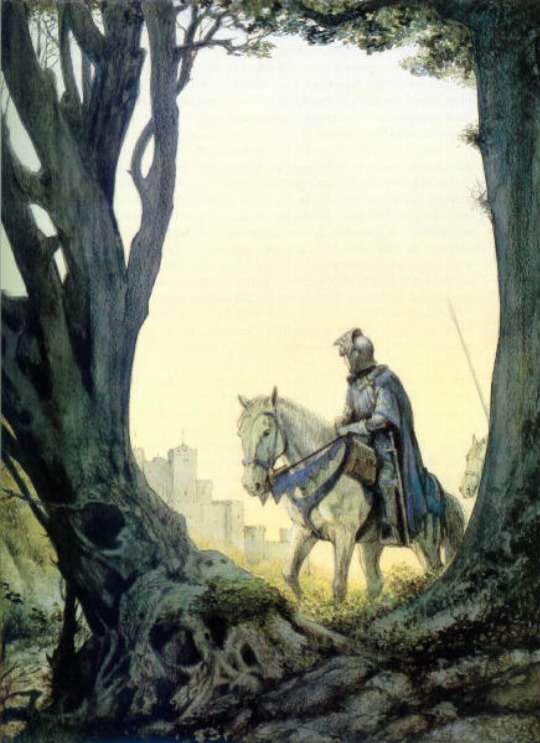
“But just as the rose is more lovely than any other flower when it opens fresh and new, so where liberality appears it surpasses all other virtues and increases five hundred times the qualities it finds in a worthy, upright man.”
Chrétien de Troyes, Arthurian Romances
#Art 🎨 by Julek Heller
8 notes
·
View notes
Quote
D'amors parolent amedui,
Car s'il d'autre chose parlassent,
De grant oisouse se meslassent.
(Chrétien de Troyes, Le Conte du Graal)
8 notes
·
View notes
